The very essence of Black heritage, inextricably linked to the stories held within each strand of textured hair, finds its most profound expression in the art of cornrows and braids. These styles are not mere arrangements of hair; they are living archives, whispered narratives of survival, resistance, and boundless creativity. To gaze upon a braided crown is to witness a lineage unbroken, a continuum stretching back to the earliest moments of human ingenuity, where the hair was a canvas for identity and a conduit for meaning. This is a story that breathes with the spirit of the ancestors, a testament to the enduring power of Black hair as a cultural compass.
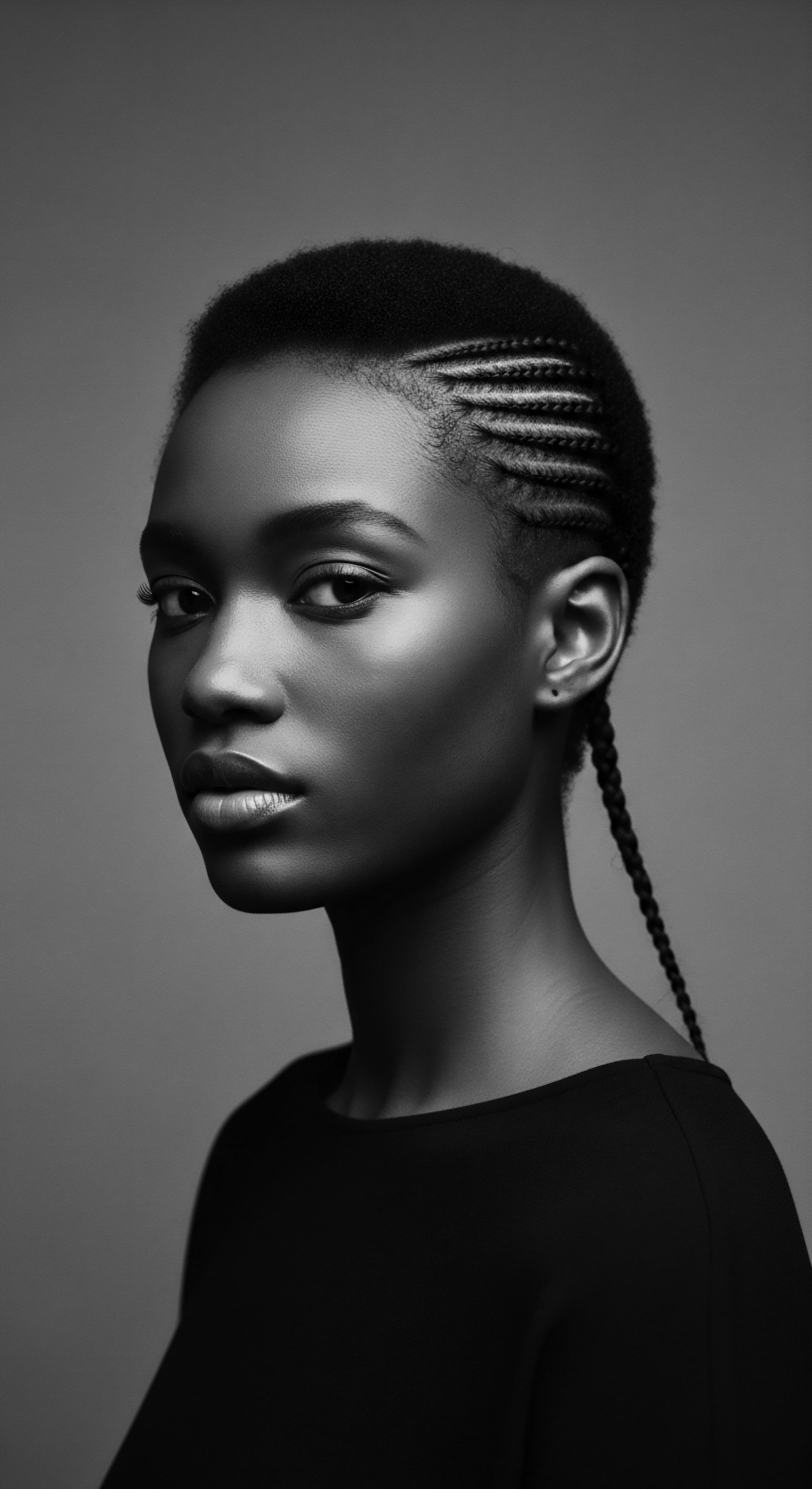
Roots
From the first touch of hand to coil, cornrows and braids have held a place of singular reverence within Black heritage, their history entwined with the very understanding of textured hair itself. Long before the advent of modern microscopy, ancient communities possessed an intuitive grasp of their hair’s unique qualities, adapting their practices to its singular biology. The hair strand, a complex protein filament, emerges from its curved follicle, creating the characteristic curls and coils that defy gravity and invite intricate manipulation. This inherent structure, scientifically understood today as a result of the elliptical cross-section of the hair shaft and the uneven distribution of keratin proteins, allows for the tight, sculptural forms that define cornrows and braids.
(Gaines et Al, 2023). This deep understanding was not abstract; it was lived knowledge, passed down through generations, informing the selection of tools and the invention of styles that protected and celebrated these crowns. The earliest known depiction of braids, found in rock paintings in the Sahara desert, dates back to approximately 3500 BCE, serving as a testament to the antiquity of this practice on the African continent. These were not just practical arrangements for managing hair in diverse climates; they were deliberate statements, a visual language spoken through patterned rows and carefully constructed forms. These practices were a testament to the ingenuity of early African civilizations, who instinctively understood the unique needs and capabilities of their hair, turning it into a medium of profound cultural expression.

Ancestral Hair Anatomy and Its Care
The ancestral approach to understanding hair was deeply holistic, viewing it not as a separate entity but as an extension of self, spirit, and community. The tightly coiled patterns of Black hair, often less densely concentrated on the scalp compared to other hair types, were instinctively recognized for their vulnerability to dryness due to the challenging path sebum must travel down the coiling shaft. This inherent characteristic spurred the development of rich, natural emollients and protective styles. Ancient Egyptians, for instance, were meticulous in their hair care, utilizing scented oils and lotus flowers to maintain their elaborate braided and cornrowed styles.
The Kushite kingdom, with its wealthy elite and powerful queens, showcased hairstyles that celebrated natural hair textures, with tightly bound rows and curls frequently seen in temple carvings, signifying both authority and lineage. This commitment to preserving the hair’s natural state through protective braiding was a fundamental aspect of daily life, connecting present practices to timeless ancestral wisdom .
The journey of cornrows and braids begins with the very helix of textured hair, a biological blueprint that inspired millennia of artistic and symbolic expression.
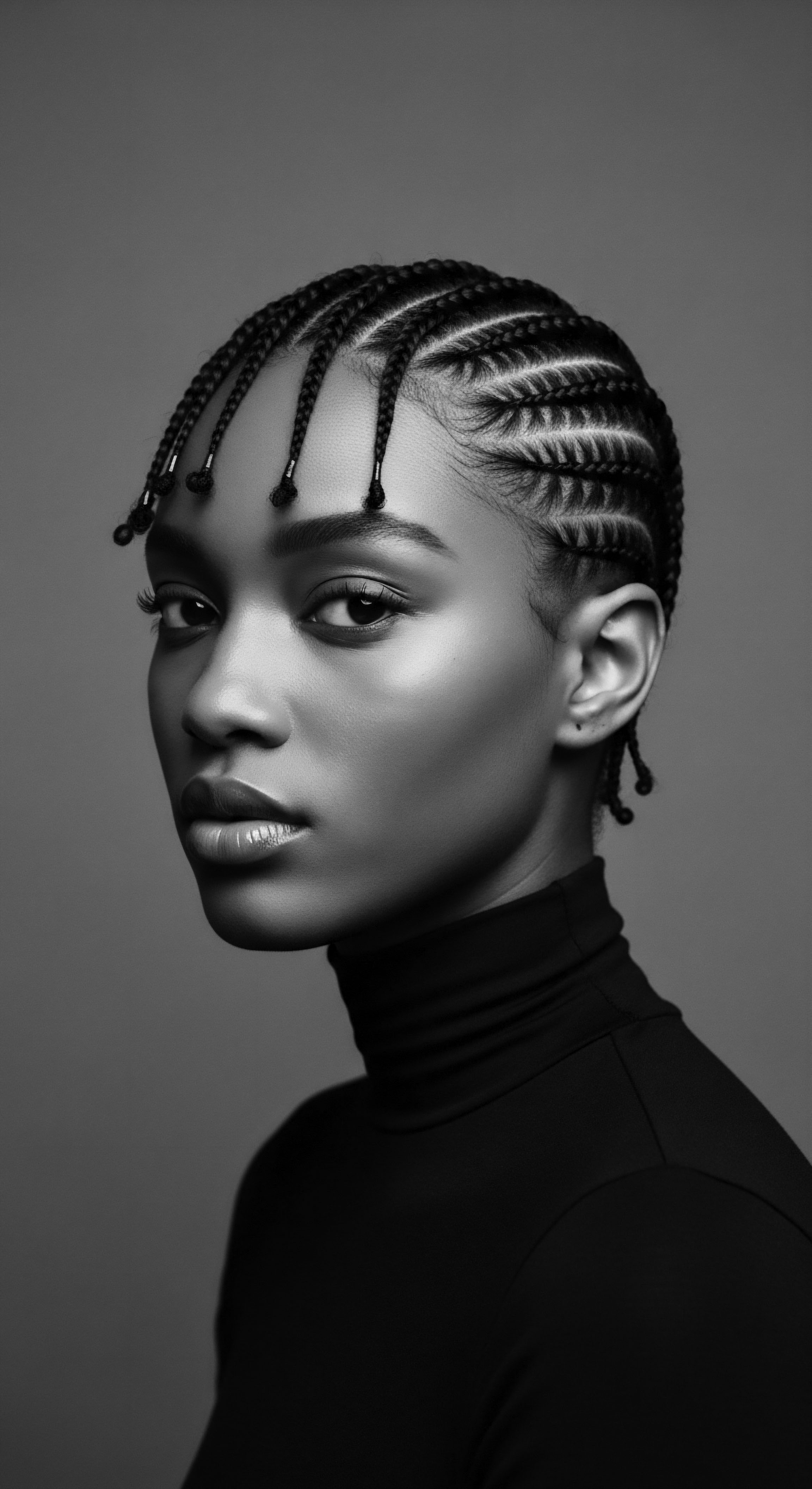
The Lexicon of Black Hair and Its Cultural Echoes
The words used to describe textured hair and its styles are not merely labels; they are linguistic artifacts carrying the weight of centuries of cultural meaning. The term “cornrows” itself, a direct descendant of the agricultural rows worked by enslaved people in colonial America, speaks to a painful history of forced labor and adaptation. Yet, before this imposed terminology, African societies possessed their own rich vocabulary. In Yoruba, for example, the general term for cane/cornrows is ‘Irun Didi,’ with ‘Irun’ translating to hair.
These ancient names carried precise meanings, identifying specific techniques, social statuses, or even ceremonial purposes. The evolution of this lexicon mirrors the diaspora’s experience, demonstrating how ancestral practices survived and adapted through resilience, allowing for the creation of new expressions that still honored their deep heritage . The intricate patterns of braids, often incorporating geometric designs, were a visual language communicating social status, age, marital status, religious beliefs, and tribal affiliations.
| Ancient Observance Recognition of hair's dry nature, necessitating regular oil application. |
| Contemporary Scientific Insight The elliptical cross-section and coiling pattern of afro-textured hair hinders sebum's descent, confirming increased dryness. |
| Ancient Observance Braids as protective measures against environmental elements. |
| Contemporary Scientific Insight Braided styles minimize manipulation and exposure, reducing breakage and promoting length retention. |
| Ancient Observance Hair as a spiritual conduit and symbol of vitality. |
| Contemporary Scientific Insight While not scientifically quantifiable, this perspective underscores the intrinsic value placed on hair wellness within cultural identity. |
| Ancient Observance The wisdom of old ways frequently finds affirmation in the clarity of modern scientific investigation, illuminating the enduring power of heritage in hair care. |

Ritual
The rendering of cornrows and braids extends beyond mere technique; it is a ritual, a communal act, a tender thread connecting generations through shared touch and inherited knowledge. From the earliest communal gatherings where hair was sculpted, to the intimate moments between mother and child, these styles have always been more than aesthetic choices. They are living traditions, embodying the art and science of textured hair styling.
The very act of braiding is a social art, often taking hours, fostering bonding between individuals and transmitting cultural practices from one generation to the next. This is where the wisdom of the hand meets the knowledge of the past, creating patterns that resonate with deep cultural meanings and a collective memory.

What Were Early African Protective Styles?
Protective styling, with its roots in ancestral ingenuity, is a hallmark of Black hair care. Cornrows and braids, by securing the hair close to the scalp, protect delicate strands from environmental damage and reduce daily manipulation, allowing for length retention and overall hair health. These ancient techniques served a dual purpose ❉ practical protection and profound cultural expression. The Fulani braids , for instance, from the Fulani people of West Africa, are characterized by thin, decorative braids often adorned with beads, cowrie shells, and other embellishments.
These styles not only showcased artistic beauty but also identified a person’s tribal affiliation, marital status, and social standing. In some cultures, specific patterns of cornrows could signify age, social status, or even lineage, acting as a visual language. The Maasai people of East Africa utilized thick, elaborate braids, sometimes dyed with red ochre, representing wealth and status, often incorporating animal hair for added length and volume. These are but glimpses into an extensive encyclopedia of styles, each a testament to a unique heritage .
The act of braiding was, and remains, a sacred practice in many communities. It fostered social bonds, often performed in communal settings, serving as a way to pass down traditions from one generation to another. The time spent braiding became a space for storytelling, for instruction, for maintaining oral histories. This intergenerational sharing of skill and cultural meaning underscores the profound social role of these hair practices within Black families and communities.

How Did Enslaved People Use Braids as a Form of Resistance?
During the transatlantic slave trade, when millions of Africans were forcibly removed from their homelands, hair braiding became a powerful tool of cultural preservation and resistance. Slaveholders often shaved the heads of enslaved Africans to strip them of their cultural identity. Yet, the practice of braiding persisted, becoming a clandestine means of communication and survival.
In the oppressive crucible of slavery, cornrows and braids became a silent language, weaving escape routes and hope into strands of defiance.
A striking example of this defiance comes from Colombia , where enslaved people used cornrow patterns to create maps, indicating escape routes and safe houses. For instance, women would braid a style called ‘depates’ with thick, tight braids tied into buns on top, signaling their intent to escape. Another style featured curved braids, tightly laid on the scalp, to represent the roads they would travel. Within these braids, they often hid seeds or even gold fragments, ensuring nourishment and a means of survival after escaping.
This incredible ingenuity transformed an everyday practice into a tool of liberation, a testament to the resilience and resourcefulness of a people fighting for their freedom. The city of San Basilio de Palenque in Colombia, founded by escaped enslaved individuals led by King Benkos Bioho in the 17th century, stands today as the first free African town in the Americas, its tradition of braiding cornrows continuing to honor this legacy.
- Himba Braids ❉ In Namibia, Himba people use dreadlocked styles coated with red ochre paste, signifying their connection to the earth and ancestors.
- Yoruba Styles ❉ Nigerian Yoruba people crafted intricate hairstyles to symbolize community roles and spiritual significance, often performed by respected braiders.
- Fulani Braids ❉ Known for their thin, decorated braids with beads and cowrie shells, used to display wealth, family connections, and marital status.

Relay
The journey of cornrows and braids, from their origins as ancient cultural markers to their role as symbols of modern identity, is a profound relay of heritage through time. This relay carries not only visual patterns but also ancestral knowledge about hair health, care rituals, and the enduring power of self-expression. The continued presence and evolution of these styles speak to a collective memory, a living library of practices that defy erasure and continue to shape the future of textured hair.
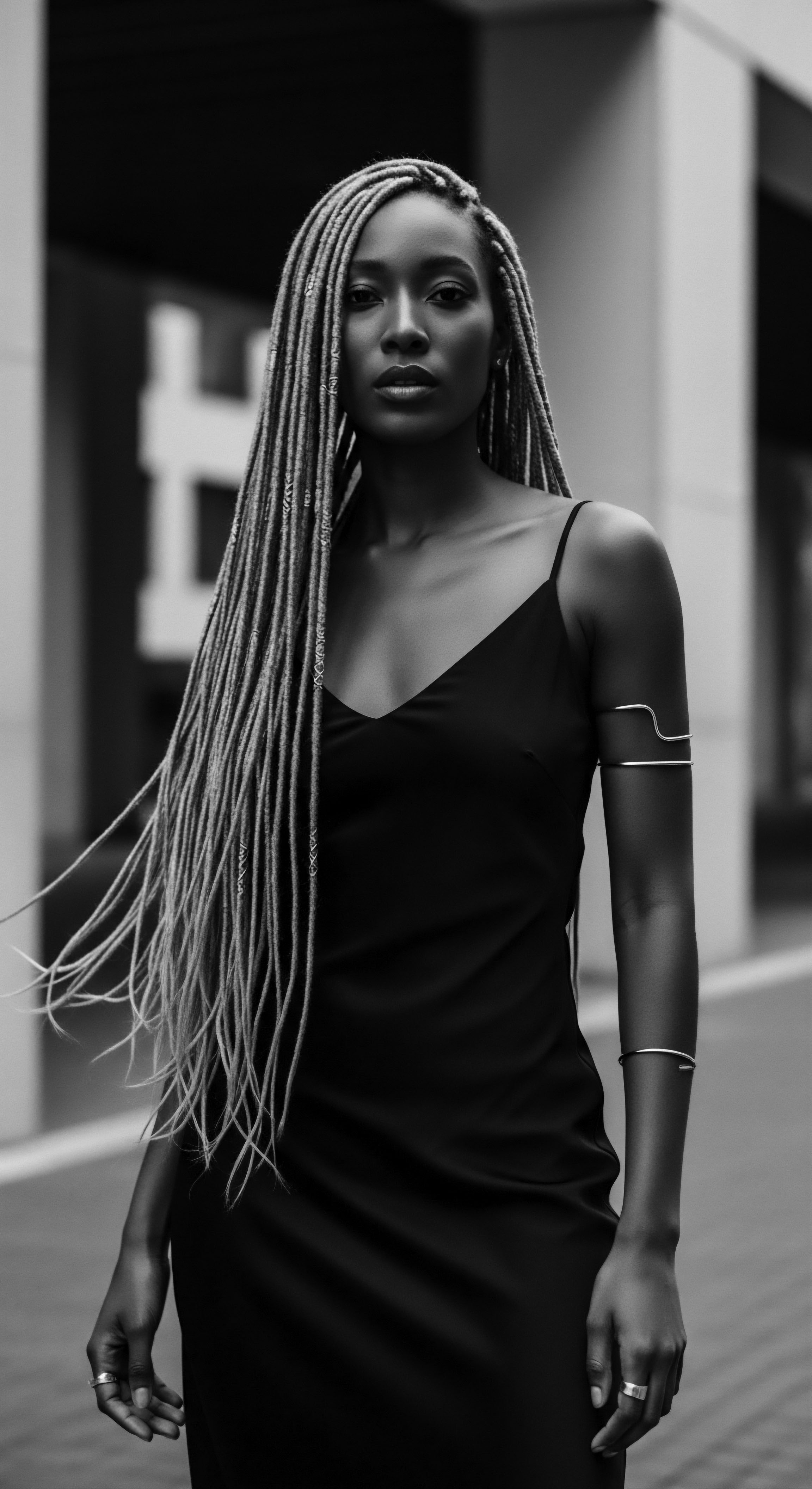
Connecting Ancient Care to Modern Regimens?
The core principles of holistic hair care, as understood by ancestors, remain remarkably relevant today. The emphasis on gentle manipulation, the protective nature of braids, and the use of natural ingredients formed the bedrock of ancient regimens. Modern hair science now often validates these long-standing practices. For instance, the traditional use of rich butters and oils like shea butter and coconut oil, common across Africa, is now understood to be crucial for moisturizing afro-textured hair, which is prone to dryness due to its coiled structure.
These traditional ingredients, often sourced locally, were chosen for their moisturizing and protective qualities, embodying an intuitive understanding of the hair’s needs. The practice of “African threading,” for example, traditionally used in West and Central Africa, wrapped and protected hair while creating intricate styles, showcasing an early form of low-manipulation styling.
The nighttime sanctuary, for example, a practice essential for preserving hair health, has its roots in traditional care. Protecting hair at night, often with scarves or bonnets made from natural materials, prevents moisture loss and friction, mirroring the ancestral understanding of sustained hair wellness. While modern products might offer new formulations, the underlying wisdom of gentle care, consistent moisture, and protective styling remains a continuous thread from the past to the present, underscoring the enduring heritage of Black hair care.
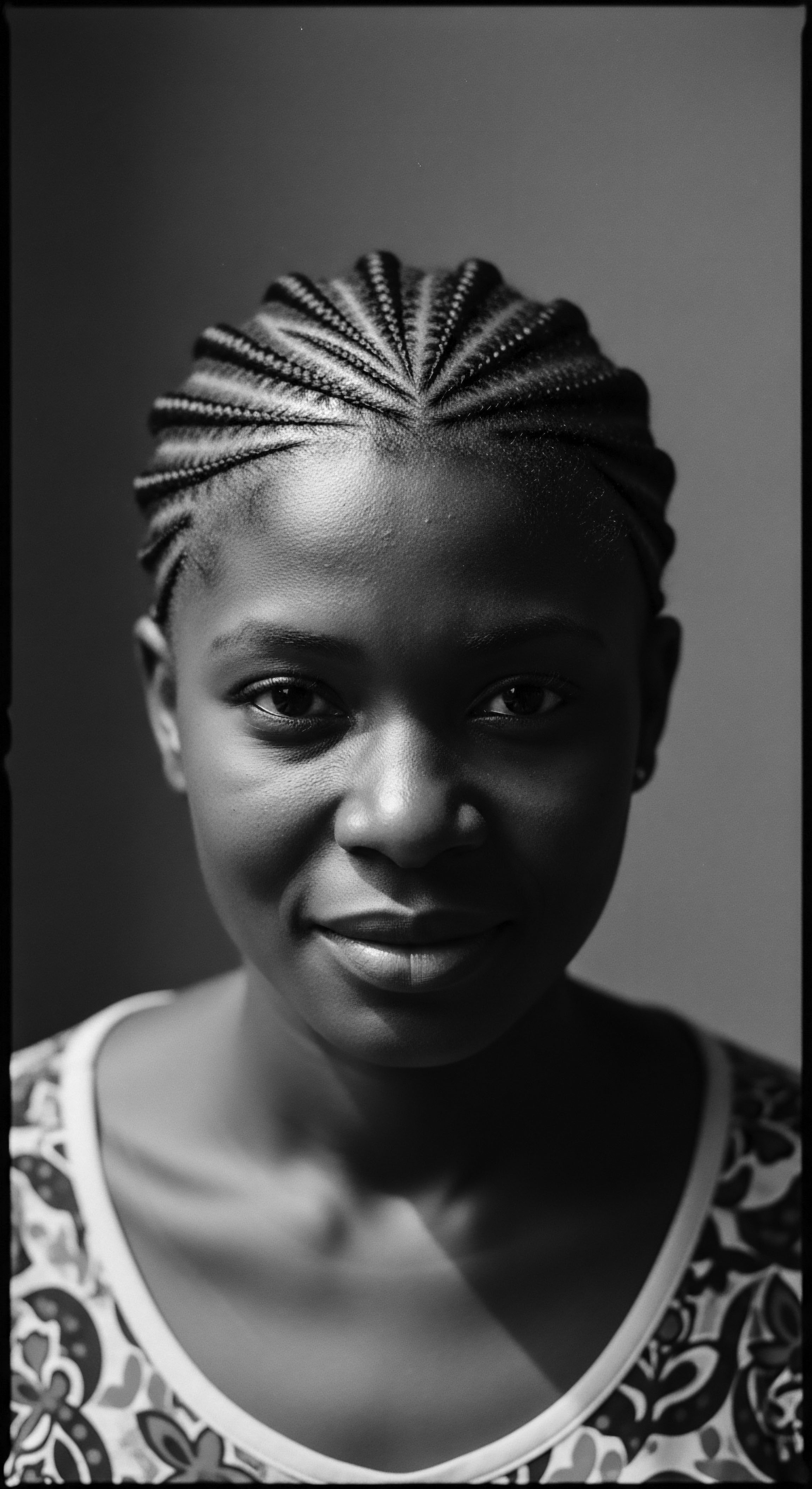
What is the Importance of Traditional Ingredients in Textured Hair Care?
Traditional ingredients hold a unique position within the heritage of textured hair care, their efficacy proven over centuries of use. These substances, often derived from local flora and fauna, were selected not only for their availability but for their inherent properties that nurtured and strengthened the hair. Consider:
- Shea Butter ❉ A staple from West Africa, revered for its conditioning and sealing properties, it provides a protective barrier against moisture loss.
- Marula Oil ❉ Originating from Southern Africa, this oil is known for its moisturizing capabilities and antioxidant content, offering deep hydration.
- Ghee (Clarified Butter) ❉ Used in Ethiopian communities, this traditional butter serves to moisturize and strengthen hair, highlighting the inventive use of readily available resources for hair health.
- Chebe Powder ❉ Hailing from Chad, this blend of herbs is celebrated for its ability to increase hair thickness and length retention by sealing in moisture.
These ingredients are not merely historical footnotes; they are living components of a care system that continues to sustain and revitalize textured hair, offering a profound link to ancestral practices and the earth’s bounty.

How Do Braids Express Identity in the Modern Era?
Today, cornrows and braids stand as powerful symbols of Black identity, cultural pride, and collective resistance against historical discrimination. The journey from coded maps to contemporary statements of selfhood reflects a continuous reclaiming of heritage . During the Civil Rights Movement, natural hairstyles, including braids, became emblems of Black pride and a rejection of Eurocentric beauty standards. Icons like Angela Davis popularized the Afro, a hairstyle that shared the same spirit of cultural affirmation.
The return to natural hair and traditional braiding styles in recent decades signifies a powerful resurgence, a conscious choice to celebrate inherited beauty and ancestral knowledge. This resurgence is not just about aesthetics; it is a declaration of autonomy, a visible connection to a rich cultural past that informs present-day self-perception and shapes aspirations for the future. The ability to express one’s story through their hair, whether it be a simple set of cornrows or an intricate braided style, underscores the enduring power of this heritage.
| Historical Context Pre-colonial African societies |
| Cultural Expression/Significance Social status, age, marital status, tribal affiliation, spiritual beliefs, community roles. |
| Historical Context Transatlantic slave trade |
| Cultural Expression/Significance Coded messages, maps for escape, sustenance storage, cultural resistance, preservation of identity. |
| Historical Context Civil Rights Movement |
| Cultural Expression/Significance Symbols of Black pride, rejection of Eurocentric beauty norms, statement of empowerment. |
| Historical Context Contemporary diaspora |
| Cultural Expression/Significance Self-expression, artistic creativity, celebration of cultural heritage, global influence in fashion. |
| Historical Context The evolution of cornrows and braids reflects a consistent adaptation to circumstances, always retaining a core commitment to identity and heritage. |
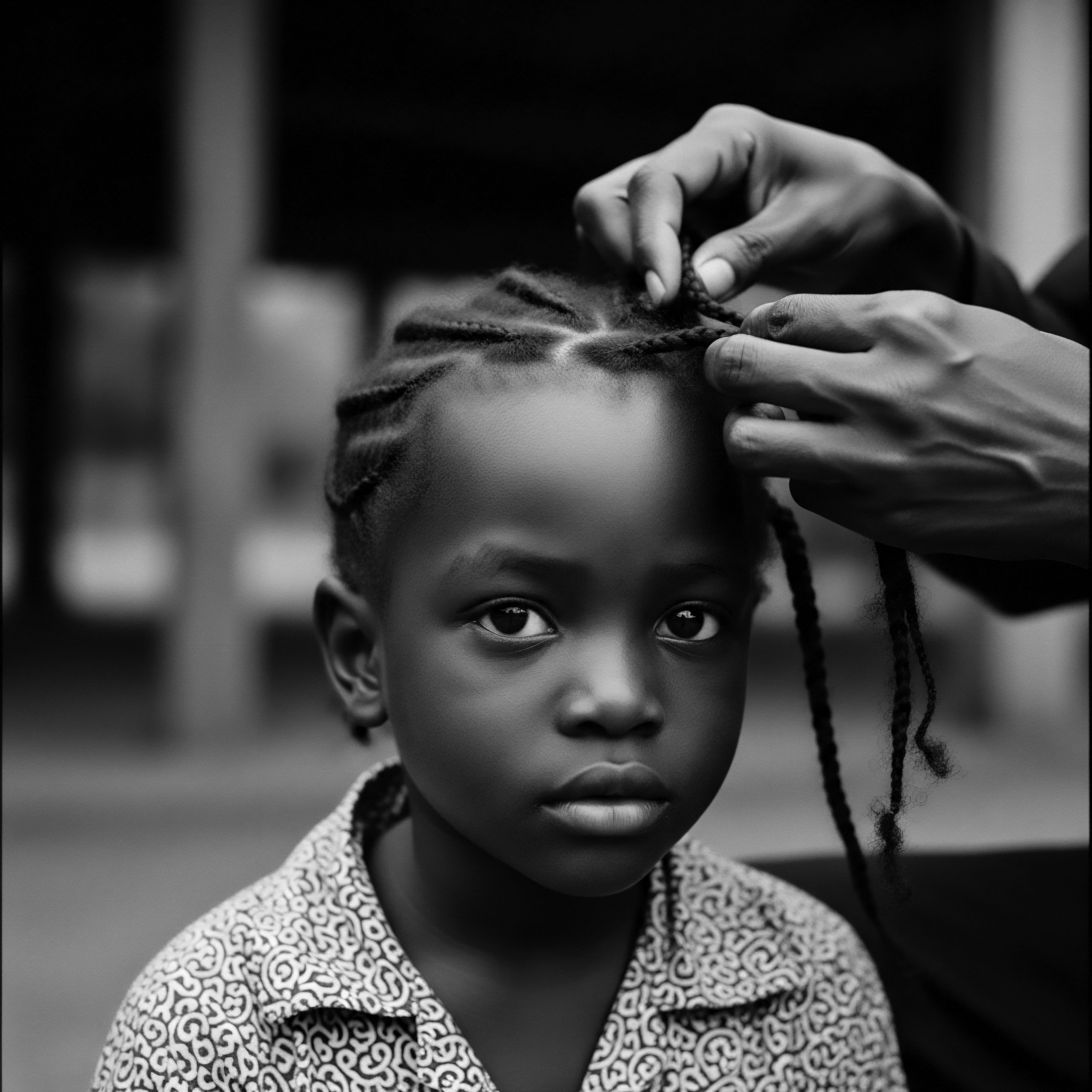
Reflection
The whispers of history, carried on the gentle undulations of textured hair, remind us that cornrows and braids are far more than stylistic choices. They are ancient echoes, tender rituals, and powerful statements of enduring heritage . Each coil and plait holds within it generations of artistry, wisdom, and profound resilience. To connect with these styles is to commune with a living archive, to recognize the sacred journey of Black hair from the fertile soil of Africa to the crowns worn today across the globe.
It is a continuing testament to the ingenuity of a people who, through every challenge, found ways to express their spirit, their stories, and their unbroken connection to ancestry through the very strands that grow from their heads. The “Soul of a Strand” truly finds its fullest meaning in this profound and ongoing dialogue between past and present, a heritage expressed in every carefully crafted row.

References
- Gaines et Al. “Coils & Curls ❉ A Mathematical Tapestry of Black Hair”. Algorithmic Pattern, PubPub, 2023.
- Obat, Dolapo. “The Intricate Tapestry of African Braided Art”. DOLAPO OBAT, 17 Dec. 2023.
- OkayAfrica. “A Regional Walk Through The History of African Hair Braiding”. OkayAfrica.
- Sherrow, Victoria. Encyclopedia of Hair, A Cultural History. Greenwood Press, 2006.
- Adoukè, Doria. “Unveiling the Rich History and Origins of Cornrows”. Doria Adoukè, 14 May 2023.
- BLAM UK CIC. “The history of Black Hair”. BLAM UK CIC, 15 Sep. 2022.
- Ajao, Tabitha. “Black History Month 2022 ❉ The History Behind Cornrows”. Beds SU, 7 Oct. 2022.
- Glamour South Africa. “The ART of cornrows ❉ How cornrows are shaping modern hair trends”. Glamour South Africa, 20 Nov. 2024.
- Afriklens. “African Hairstyles ❉ Cultural Significance and Legacy”. Afriklens, 1 Nov. 2024.
- Hicks, Mitti. “How Braids Were Used By Enslaved People To Escape In South America”. Travel Noire, 20 May 2021.
- Odele Beauty. “A History Lesson On Hair Braiding”. Odele Beauty, 16 Jan. 2024.
- Estherotomi. “BLACK HAIR SCIENCE ❉ THE STRUCTURE OF AFRO TEXTURED HAIR”. estherotomi, 10 Jun. 2015.
- Adoukè, Doria. “All you need to know about afro hair”. Doria Adoukè, 21 Jun. 2022.
